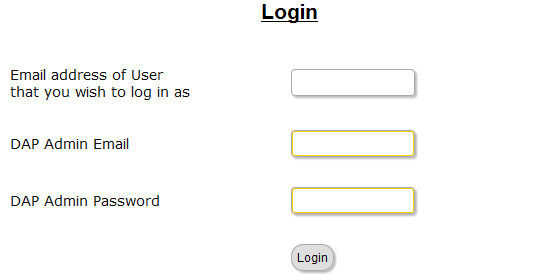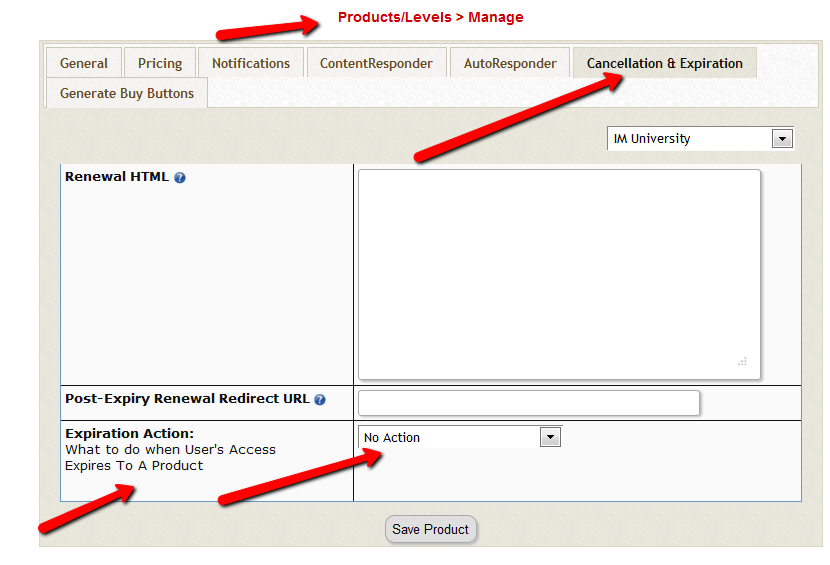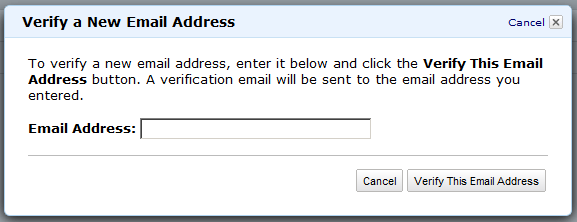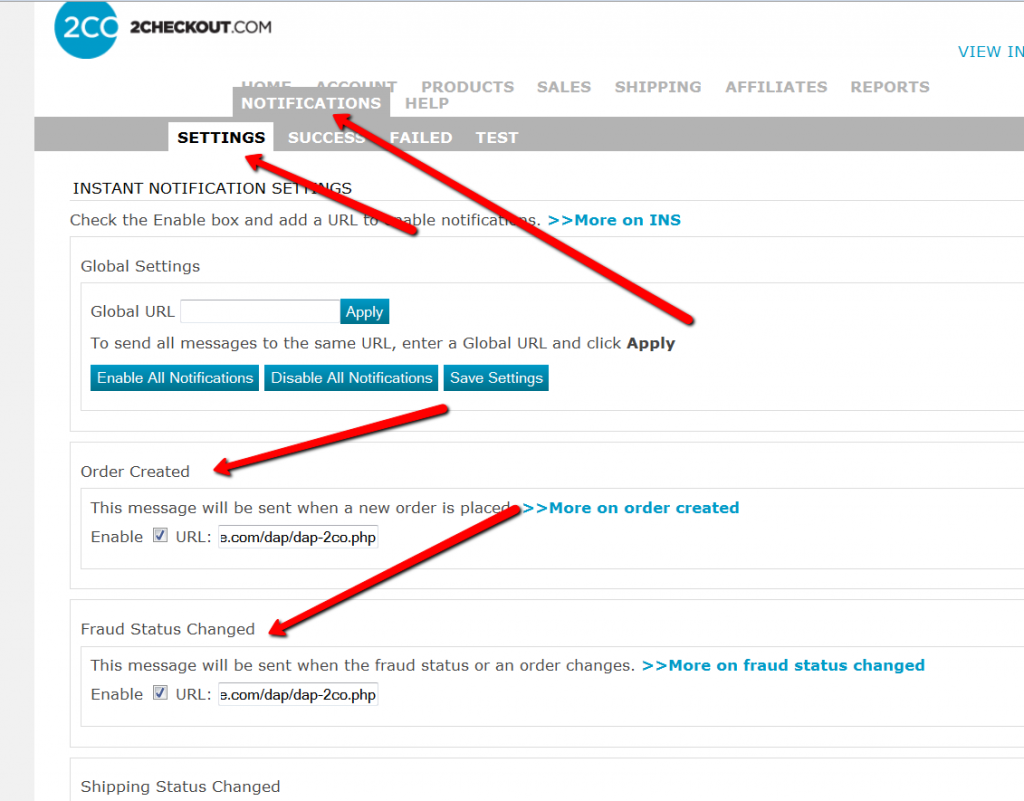Expiration Notifications / Renewal Reminders
We have a new feature starting DAP v4.4: “Reverse Dripping”
This is where you can drip emails “X” days (where “X” is a number of your choice) before the access to a product ends for a member. So this is what you would use to send expiration notification / renewal reminder emails to your members.
To setup a renewal reminder email, you would set up the email as usual, and drip it as a negative day. So if you set up the email to drip on Day “-1”, then it means the email will be sent out 1 day prior to product expiry (for that product).
If you set it up to drip on “-3”, it will be sent out 3 days prior to access end date.
If you set it up to drip on “-7”, it will be sent out 1 week prior to access end date.
Renewal Reminder Email Setup
Warning: This is something you should set up only for recurring products that require manual renewal. Do not set up these emails to go out for automated subscription products, because the members will be charged automatically on the designated day every month, and asking them to renew will only confuse them.
- Create a new Autoresponder email with the product expiration notice, at Email > Autoresponders. In this email, you would say something like “Hey, your subscription is expiring in 1 week, so click on this link to renew… (followed by link to renewal page)”.
- Create another email that says “Hey, your subscription is expiring tomorrow…”.
- Go to Products > Manage and choose product for which you wish to set up renewal reminder.
- Switch to “Autoresponder” tab.
- Select the 7-day renewal reminder email from step 1 and add it to the product.
- Then click on the “Edit” link and set the drip day as -7
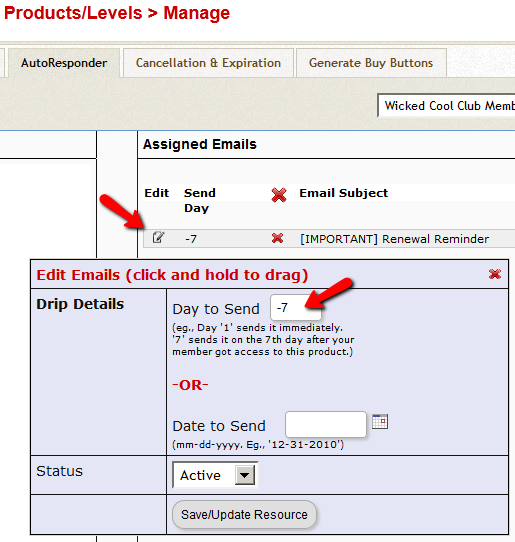
- Do the same for the 1-day reminder email as well, and this time set the dripping to be “-1”.
That’s it!
Log In As Member
Starting DAP v4.4, all passwords are encrypted. Previously, one of the main reasons that we had made it open, was because of many DAP admins asking for it to be that way so that they could log in “as” one fo their members to see what they’re seeing, for troubleshooting, etc.
But since the passwords are now encrypted, we have provided an alternate way for DAP admin to log in as a regular user/member.
Log In As Member (LIAM)
- If your primary browser is say Firefox where you’re normally logged in as WP admin and DAP admin, then open a separate browser window (like in Chrome or Safari)
- Go to http://YourSite.com/dap/loginAs.php
On that page, you will see 3 form fields as shown in the image below:
1) Email address of user/member that you wish to log in as
2) DAP Admin Email
3) DAP Admin Password
So once DAP verifies that it is indeed the DAP Admin trying to log in as someone else, DAP will log you into the site as that member whose email id you entered in (1) above.
NOTE: The Log In As Member (LIAM) feature does NOT mean that you can use just one browser to log in as both DAP Admin and regular member. You still need to use two separate browsers – one for DAP admin (like Chrome) another for regular member (Firefox). All LIAM does is to give you a workaround for logging in as someone else, because starting 4.4, the DAP Admin can no longer see what the member’s password is in order to log in as them.
Credit Store Setup
Credit Store Setup
The document below explains how to setup this plugin after you have installed it using these instructions.
Please NOTE:
1) The prerequisite for using this plugin is you must be on DAP 4.5.2 or above. It is not supported by older versions of DAP. If you are not on dap 4.5.2 or above, then please make sure to first upgrade to the very latest version of dap and then follow the steps below to install the DAP Credit Store Plugin.
2) Credit Store is NOT backward compatible with old plugin called SSS (Self-Service-Store). If you are using the very old SSS plugin and upgrade to CS, you will have to start over with new CS as the data stored in SSS tables cannot be migrated over to the CS tables and your old SSS plugin will no longer work after the upgrade to new CS.
3) If you are already using the OLD Credit Store plugin, then please contact us before you upgrade to the new CS as the new CS has a completely different store front user interface (UI). If you are ok with upgrading to the new and much improved look&feel, please make sure to first take a full database backup of the dap database and a backup of your dap and daplivelinks folder.
Steps to setup the Credit Store:
1. Enable Credit Store
Set DAP admin -> setup -> config – > Credit Store -> Enable Self-service / Credit Store to “Y”.
2. Credit Store Front Layout / Templates
Visit this page for detailed documentation on this.
2. Create a Credit Store Front page
Login to WP admin -> Add New page -> Visual Editor -> You will find a new CS Editor button. Click on that to configure storefront options.
Visit this page for detailed documentation on this.
3. Create Product Category in DAP admin -> Add / Edit Product Category page
Visit this page for detailed documentation on this.
4. Create Master Product
Visit this page for detailed documentation on this.
5. Enable self-service for the master.
After you create the master product, go to DAP Admin -> Credit Store -> Store Front Settings page.
Select the master product you created above and set the following values:
– Is this the “Master” product? Set to “Yes”.
– Redeemable with Credits? Set to “No”.
– # of Credits the users will earn when they signup to this product or purchase this product (set it to whatever number of credits you want the users to earn when they signup or purchase this product.
– # of Recurring/Subscription Credits assigned to this product
6. Create Child Product
Visit this page for detailed documentation on this.
7. Enable self-service for the child product(s).
After you create the child product, go to DAP Admin -> Credit Store -> Store Front Settings page. Select the child product you created above (step #6) and set the following values:
– Self-Service allowed? Set to “Yes”.
– Is this the “Master” product? Set to “No”.
– Self Service Availability Start Date and End date (you can leave the default value for the start date (set to today/current date) and end date of 9999-12-31.).
– Allow credits to be redeemed at content level – set to Y if you want to allow users to redeem credits for individual content instead of purchasing the entire product.
– Resell Product: Allow users to redeem already redeemed products ? You CANNOT resell product if you allow ‘credits to be redeemed at content level’.
After a user redeems their credits against the product or against individual content, these products will disappear from store.
If resell product is “Y”, users will still see the product in credit storefront even after they have redeemed their credits towards the purchase of the product.
If resell product is “N”, users will NOT see the product in credit storefront after they have redeemed their credits towards the purchase of the product.
– Product Image URL – must start with ‘http://’. If no images are set, the product will appear with no-image in the storefront page.
– Product Image URL Hyperlinked To: what page do you want to take the user to when the users click on the product image.
– # of Credits assigned to this product: this is calculated dynamically by adding up credits assigned to individual content if ‘allow content level credits’ is enabled.
If allow content level credits’ is “N”. the # of Credits assigned to this product is used.
8. Associate child product(s) to the category
Go to DAP products/Levels -> Credit Store page. Associate child product(s) to any of the product category(s) created in step # 2.
You will find the option to associate child to master below the self-service-store options (under Add Products to Category).
NOTE: A credit store child product cannot participate in regular content dripping. You cannot sell the same child product for $ as well as allow it to be redeemed using credits. You will have to use 2 separate products (one for regular dripping and the other for credits).
9. Configure Credit StoreFront page using CS editor
10. Testing
Now login to dap admin, go to dap admin -> add users page, give the admin user access to master product. Say the master product is assigned 10 credits.
Go to dap users -> manage page=> click on the ‘Credits’ field and it will show how many credits the user has.
Now go to the credit storefront page created in step #9. You should see all the child products available for redeem (only child products that are associated to category will show up in the store).
You can redeem the entire child product, and go back and check dap users -> manage page=> click on the ‘Credits’ field and it will show how many credits the user is left with.
Credit Store Introduction
The Credit Store Plugin will allow you to sell “Credits” to your members, and then your members can “Redeem” those credits towards the purchase of any content you’ve made available in your Credit Store. Similar to buying credits at Audible.com or earning credit card reward points.
The Credit Store plugin enables “Content On Demand“. Instead of you dripping content on your members in a pre-determined fashion, they choose the modules they want, and the order in which they want them. You just give them the credits putting the power of choice at their fingertips.
You can configure the plugin to Pay Affiliates by credits (for leads and sale) which they can then use to pay for their own purchases and subscriptions on your site.
You can also allow your users to earn ‘Social-Media-LIKE‘ credits OR ‘Comment‘ credits.
Credits are like currency, your users can use the earned credits to buy your entire product or buy individual content (pay-per-post-using-credits).
For ex, say you signup for an audible.com membership plan where you are awarded one audible.com credit a month. Most of the books on Audible can be “bought” for one credit, so you can usually get at least one book a month with your membership or you can accumulate credits for a few months and then go to the store to buy whatever products you want in exchange for credits. You can setup a similar storefront and rewards-program for your members instantly using our credit store plugin.s
Say you offer silver, gold, platinum monthly memberships. You can charge more for your gold membership than silver but offer more free credits as bonus. Similarly you can charge more for your platinum membership than gold but offer a lot more free credits as bonus. These users can then use the earned credits to browse your store and get content of their choice. So you can quickly setup a rewards program where you reward users based on the membership plan and your users will get automatic access to the rewards program when they enroll so they can start earning points and redeeming them at your store right away.
Members receive credits that can be used as currency on your site and applied to any purchase of products that you have made available in your store.
With the credit store plugin, setting up a storefront page (where your users can buy the product of their choice using credits) is a breeze. You can literally setup a storefront page in less than 5 minutes.
To summarize, the Credit Store plugin will allow you to create an Instant Credit Storefront Page where:
1) You (Site Owner) can display the products that can be redeemed for credits and
2) Your users can come to this page to Redeem their Earned Credits/Points.
Please read this document before you use this plugin.
Note: The prerequisite for using this plugin is you must be on DAP 4.4.x. It is not supported by older versions of DAP. If you are not on dap 4.4.x, then please make sure to first upgrade to the very latest version of dap 4.4.x and then follow the steps below to install the credit store plugin.
WARNING: If you are a self-service-store user and already have a lot of self-service-store users, then DO NOT upgrade to dap 4.4.x as it is NOT backward compatible with OLD SSS. We have completely revamped the old SSS plugin and now it’s called CreditStore (CS). We had to update the underlying dap scripts and dap tables/fields for the NEW CS plugin and it was NOT possible to make the scripts / tables work with both OLD SSS and NEW CS. If you can simply upgrade to 4.4.x and use the NEW CS plugin and manually give your existing SSS users access to new CS plugin, then it will work fine. There is NO automatic way to move old SSS users to new CS model.
Sell credits to your users
If you have a one-time (free or paid) or a subscription product, and you want to allow your users to earn credits when they buy the product or when a recurring payment comes in, then all you need to do is define / designate the product as Master in DAP products/levels- >Credit Store Front Settings page and ‘Assign Credits’ to that product (initial credits and recurring credits) in that page.
Here’s what you can do with the product defined as master (that allows users to buy credits).
- The master product can be a regular full-fledged dap product that you sell. You can drip content (if reqd) under the master like any normal dap product. The only thing with product that you have set as master is in addition to doing everything a regular dap product does, this master product will allow your users to earn credits. If a user gets access to this product (via free signup or via purchase), they will get the credits assigned to this product. So you can use credits during a special promo and tell your users that if they signup or buy the product, they will earn credits in addition to the content that they are buying and they can use the credits in the store towards available child products. Or you can simply setup a master as a way for your users to purchase credits. It can be a dummy product setup just to allow your users to purchase credits. You can setup the payment button for master like you would for any dap product. DAP will know to automatically award credits to the user when the purchase is complete. You will find the assigned credits to user in the dap users->manage page under ‘Credits’ column.
- Users that purchase the product designated as master, will earn credits assigned to that product and in addition, will also get access to any dripped content under the master.
- Master product can be a one-time or a recurring/subscription product.
- User-Level-Credits. The credits the users earn will be accumulated in the user’s account and they can use the accumulated credits towards ANY redeemable child products in the credit store.
- Option to assign recurring credits : The users will earn recurring credits (if configured under DAP products/levels- >Credit Store Front Settings page) upon each subscription payment.
Provide different ways to your users to EARN credits
Users can earn credits in several different ways:
- Signup to FREE product and earn credits (provided you have setup the product as master and assigned credits to it in DAP products/levels- >Credit Store Front Settings page).
- Purchase one-time dap product and earn credits as bonus. Users that purchase the product designated as master, will earn credits assigned to that product and in addition, will also get access to any dripped content under the master.
- Purchase a membership / subscription product and earn credits every month (or every recurring cycle) if the product has recurring credits assigned to it.
- Affiliate Lead Credits: Affiliates can earn credits for referrals that lead to signup (provided you have setup credits for the product in the DAP admin -> Affiliate -> Commissions page)
- Affiliate Sale Credits: Affiliates can earn credits for referrals that lead to sale.
-
Comment Credits : Users can comment on a credit enabled page and if comment is approved (or if set to auto-approve), the user will earn assigned credits. This is NOT part of the core Credit Store Plugin. You will need our SocialCredits plugin to enable Social Media credits.
-
Social Media Credits : Users can LIKE a page/post to a Social Media Source (Facebook, Twitter, Linkedin, G+) and earn assigned credits. DAP Admin can assign different number of credits for each Social Media Source. For ex- Facebook like can be assigned 10 credits, Twitter can be assigned 5 credits etc. This is NOT part of the core Credit Store Plugin. You will need our SocialCredits plugin to enable Social Media credits.
Setup Products redeemable in the store
- Redeemable products need to be defined as ‘Child’ in the Credit Store configuration (DAP products/levels- >Credit Store Front Settings page)
- All redeemable products will automatically appear in the store (depending on Credit Store settings in DAP products/levels- >Credit Store Front Settings page).
- Resell products: By default, if a user has already purchased a product, it will automatically disappear from that user’s view of the credit store. If you want the users to be able to redeem the same product for credits again, then set resell product setting to Y in the DAP admin -> Credit Store page. If you allow ‘content-level-credits‘ for your child product in the Credit Store Front Settings page in dap admin , then you cannot set ‘resell’ to “Y”. The resell to “Y” can only be used if you only allow users to redeem entire product and do not allow users to redeem individual content setup under that product’s “content responder” section.
- Pay-Per-Post using credits: Accomplish this via content-level credits. User will have the option to either redeem their earned credit to get access to the entire product (in this case they will get access to all content available under that product) OR they can redeem access to individual pieces of content (page / post / video / resource) under that product. Content-level credits can be enabled in dap admin -> products/levels -> credit store front page. Users can pay for the post / page / resource of interest using credits (instead of $).
Setup Product Category
- Define a category for the ‘Redeemable products‘ in the Credit Store. The category is ONLY used for display purpose in the store. If you do not define a category, and do NOT assign the products that you want to be associated to that category in the DAP products/levels- >Credit Store Front Settings page, then NO products will show up in the Credit Store Front end. So make sure to setup a product category (DAP admin -> Products / levels -> Add/Edit Credit Store Category page) and then go to DAP products/levels- >Credit Store Front Settings page and associate the child products to that category. For example – you could have an internet marketing category and associate your facebook secrets, twitter secrets products to that category.
- You can display single category per credit store page OR you can display all the categories (and redeemable products belonging to it) on the same Credit Store page. You can create a category-level credit store page where only products belonging to a certain category shows up on that page. OR you can create a generic credit store page where products belonging to ANY category shows up.
Credit Store Page Layout – Front End
You can use a ONE product per row layout OR you can use MULTIPLE Products per row layout for your credit store front-end page.
If you have ‘content-level-credits’ enabled (pay-per-post) for any of your child product, then you can ONLY use ONE product per row layout because MULTIPLE Products per row layout will only allow for simple product boxes per row, it wont allow the complex layout that products that allow content-level-credits require.
Create Credit Store Page – Front End
After you install the plugin, you can go to the WP Admin -> Pages -> Add New – > Visual Tab -> You will find a new Editor Button called ‘CS’. You can click on that button and you will find ALL the credit store front end page setup options. Its self-explanatory. Once you have completed the setup of the page, you can publish that page and it will become the page where logged-in users can come to redeem their earned credits.
Click here for details on the various Credit Store Editor button option.
Credit Store Installation
The Credit Store plugin will allow you to create an Instant Credit Storefront Page where:
1) You (Site Owner) can display the products that can be redeemed for credits and
2) Your users can come to this page to Redeem their Earned Credits/Points.
The document below explains how to install this plugin.
Note: The prerequisite for using this plugin is you must be on DAP 4.4.x. It is not supported by older versions of DAP. If you are not on dap 4.4.x, then please make sure to first upgrade to the very latest version of dap 4.4.x and then follow the steps below to install the credit store plugin. If you have purchased our Credit Store plugin, then please follow these steps to install the plugin:
- Go to wickedcoolplugins.com/login.
- Download CreditStore.zip to your desktop.
- Now install this plugin in your WP admin panel like any other WP plugin. Go to WP admin -> plugins -> Add New -> Click on the ‘Upload’ tab -> click on browse to find he downloaded CreditStore.zip from your desktop.
- Click on Install.
- Go to WP Admin -> Plugins -> Activate this plugin
Access Expiration Options
In DAP 4.7, we have added a new feature to the hourly dap cron where once every day (it’s hardcoded to run ONCE between 10:00 PM – 11:00 PM PDT) the cron will look for users whose access expired that day.
You can configure the Cancellation Options in DAP Products page -> Cancellation & Expiration tab.
Then based on these settings, the DAP Hourly Cron will check if the current time is between 10:00 – 11:00 pm PDT (Server time), and if yes, it will take a look at each product, pick up the ‘Expiration Action’ setting for that product, then get a list of ALL users whose access to that product has expired and apply the ‘Expiration Action’ to that user->product record in DAP users -> manage page.
The reason the DAP Cron checks the current time and runs the ‘expiration job’ only once a day is because running it too often will burden your server/resources as this job needs to pick up all products and then apply the cancellation rule to all users whose access has expired.
The main thing is to make sure it only runs once.. does not matter if that’s between 10 – 11 or 11 – 12 etc. We just picked the time to be between 10 – 11 PM (server time).
1) No Action
User’s access will auto-expire at the end of current recurring cycle. If the user re-signs, they will start from where they left off instead of starting over at day 1.
Infact this is how all older versions of dap already work.
If a user cancelled access to a subscription product before and say that the same user now wants to start back after a couple of months break.
If you have selected NO ACTION as this product’s expiration setting (in dap products page -> cancellation & expiration tab),
then when the user re-signs, they will start their dripping from where they left off and will not start fresh again from day 1.
Say a user’s access start date is 07/01/2014 and access end date is 07/30/2014, when the cron runs on 07/31/2012
and finds the user’s access has expired, it wont do anything.
If the same user re-signs for the same product on 08/30/2014 using the same email id, their access start date will be what it was before (07/01/2014) and their new access end date will simply be extended from what it was before. It will be set to previous access end date (07/30) + 30 days instead of new signup date (08/30) + 30 days. User’s access to product will remain expired. You will have to set post-expiry access to “Y” in dap setup->config page for access to ‘paid-for content’.
See this for more details: Cancellation
2) Remove From Product
If selected, dap will automatically find users whose access to this product has expired and remove user’s access to product completely for those users.
You will need this setting to prevent access for expired users. Users will completely lose access to product.
If these users signs up again, they will start over like a new member.
3) Set end date to previous day
To enable this option, you will have to first enter the following in /dap/dap-config.php file.
Please ftp to your site, find dap-config.php file, edit it and add this to your /dap/dap-config.php file:
Add it towards the top after php start tag (<?php) :
if(!defined(‘EXPIREACCESS’)) define(‘EXPIREACCESS’,’Y’);
IMPORTANT: Replace all occurrences of backticks in the line above with single or double quote character.
Then upload back to your site (under dap folder).
We are forcing the dap-config.php setup in DAP 4.7 so users do not pick this option by mistake. We also want this feature to be BETA tested fully (in DAP 4.7) and then we will remove the extra steps (to add lines to the dap-config.php).(
After you set this in dap-config.php, this dropdown option will be available in the ‘expiration action’ dropdown.
If you pick this option for a product, then DAP CRON will automatically find a list of expired users (whose access has expired to this product) nightly and move the expired user’s access start and end day (set the access end date to the previous date).
When the cron wakes up and runs this job once once every night at 10:00 PM, it will move the user’s access start / end date forward in such a way that user’s access will remain expired but the access end date will not be stuck somewhere in past. It will be always set to the previous date (from current date).
Say a user’s access start date is 07/15/2014 and access end date is 08/15/2014.
When the cron runs on 08/16/2014 and finds the user’s access has expired, it will set the access end date to previous date.
So first time when the cron runs after the user’s access expires, nothing will happen. The access end date will remain 08/15 as it’s already set to previous date.
When cron runs on 8/17, it will move forward the the access start and access end window, so the new access start date will be 07/16 (moved forward by 1 day) and end date will be 8/16 (moved forward by 1 day).
This way the user’s access is still expired (as it’s always set to previous date) but the access dates are not stuck in the past.
If they re-sign, when DAP extends access, the access end date will be in the future instead of being expired.
If the cancelled user re-signs, the user’s access will not remain expired as their access will be extended from the current access end date to a date in future and the dripping will continue from where they left off.
IMPORTANT: ADDITIONAL INFORMATION
1) EXPIRATION: SET ACCESS TO PREVIOUS DATE
We recommend that you enable this option ON a test product first. DO NOT use this option on an actual live product. Add a few test users to the test product. Move their access start/end date manually to a date in the past .Make a note of it. Enable the admin option to ‘move date to previous date’ for this product. Then run the cron manually. Go back to dap manage users page and check the new access start / end dates for these users. If all looks good, then use it for live products.
2) CRON JOB:
The dap cron (dap-cron.php) runs once every hour at the top of the hour… but it will only do the expiration job between 10- 11 PM (server time). The expiration part of the cron only executes once a day.
To force run the cron, run this command in a browser (dont run cron too close to the top of the hour as it will collide with the normal running of cron ).
http://yoursite.com/dap/dap-cron.php?forcerun=Y (replace yoursite.com with the name of your site)
Product Cancellation/Expiration Options
In DAP 4.4, we have added a new feature to the hourly dap cron where once every day (it’s hardcoded to run ONCE between 10:00 PM – 11:00 PM PDT) the cron will look for users whose access expired that day.
You can configure the Cancellation Options in DAP Products page -> Cancellation & Expiration tab.
Then based on these settings, the DAP Hourly Cron will check if the current time is between 10:00 – 11:00 pm PDT (Server time), and if yes, it will take a look at each product, pick up the ‘Expiration Action’ setting for that product, then get a list of ALL users whose access to that product has expired and apply the ‘Expiration Action‘ to that user->product record in DAP users -> manage page.
The reason the dap cron checks the current time and runs the ‘expiration job’ only once a day is because running it too often will burden your server/resources as this job needs to pick up all products and then apply the cancellation rule to all users whose access has expired.
The main thing is to make sure it only runs once.. does not matter if that’s between 10 – 11 or 11 – 12 etc. We just picked the time to be between 10 – 11 PM (server time).
1) No Action
User’s access will auto-expire at the end of current recurring cycle. If the user re-signs, they will start from where they left off instead of starting over at day 1.
Infact this is how all older versions of dap already work.If a user cancelled access to a subscription product before and say that the same user now wants to start back after a couple of months break.
If you have selected NO ACTION as this product’s expiration setting (in dap products page -> cancellation & expiration tab),
then when the user re-signs, they will start their dripping from where they left off and will not start fresh again from day 1.
Say a user’s access start date is 10/01/2012 and access end date is 10/30/2012, when the cron runs on 10/31/2012
and finds the user’s access has expired, it wont do anything.
If the same user resigns on 11/30/2012, their access start date will be what it was before (10/01/2012) but their new access end date will be 10/31/2012 + 30 days (instead of 11/30/2012+30 days). User’s access to product will remain expired. You will have to set post-expiry access to “Y” in dap setup->config page for access to paid for content.
See this for more details: http://www.digitalaccesspass.com/forums/threads/741-Subscription-Cancellation
2) Remove From Product
If selected, dap will automatically find users whose access to this product has expired and remove user’s access to product completely for those users.
You will need this setting to prevent access for expired users. User will completely lose access to product.
If the user signs up again, they will start over like a new member.3) Set end date to previous day.
Automatically move the expired user’s access start and end day (set the access end date to the previous date).
When the cron wakes up and runs this job once daily, it will keep moving the user’s access start / end date
forward in such a way that user’s access will remain expired but the access end date will not be stuck somewhere in past,
it would be always set to the previous date (from current date).Say a user’s access start date is 10/01/2012 and access end date is 10/30/2012, when the cron runs on 10/31/2012
and finds the user’s access has expired, it will set the access end date to previous date.. so first time when
the cron runs after the user’s access expires, nothing will happen, access end date will remain 10/30,
but when cron runs on 11/1, it will now move the access end date to previous date so the new access start date will be 10/02/2012
but end date will be 10/31/2012 (the access start / end block is moved forward).So if the cancelled user re-signs, the user’s access will not remain expired as their access will be extended from the access end date
to a date in future and the dripping will continue from where they left off. You would probably want to use this setting if you are on DAP 4.4.
Amazon Simple Email Service (SES) Integration With DAP
DAP/Amazon SES Integration
You can hook up DAP to Amazon’s Simple Email Service (Amazon SES) and have all of your emails go through Amazon’s beefed up, high-performance, high-deliverability email servers.
The document below explains how to connect DAP to Amazon SES. (troubleshooting info for DAP/SES integration)
- Go to http://aws.amazon.com/ses/ and sign up for Amazon SES. You must already have an Amazon account and you can add SES to that same account.
- Then go to https://console.aws.amazon.com/console/home , log in if required, and click on the SES link there.
- That will bring you to the SES “Dashboard”.
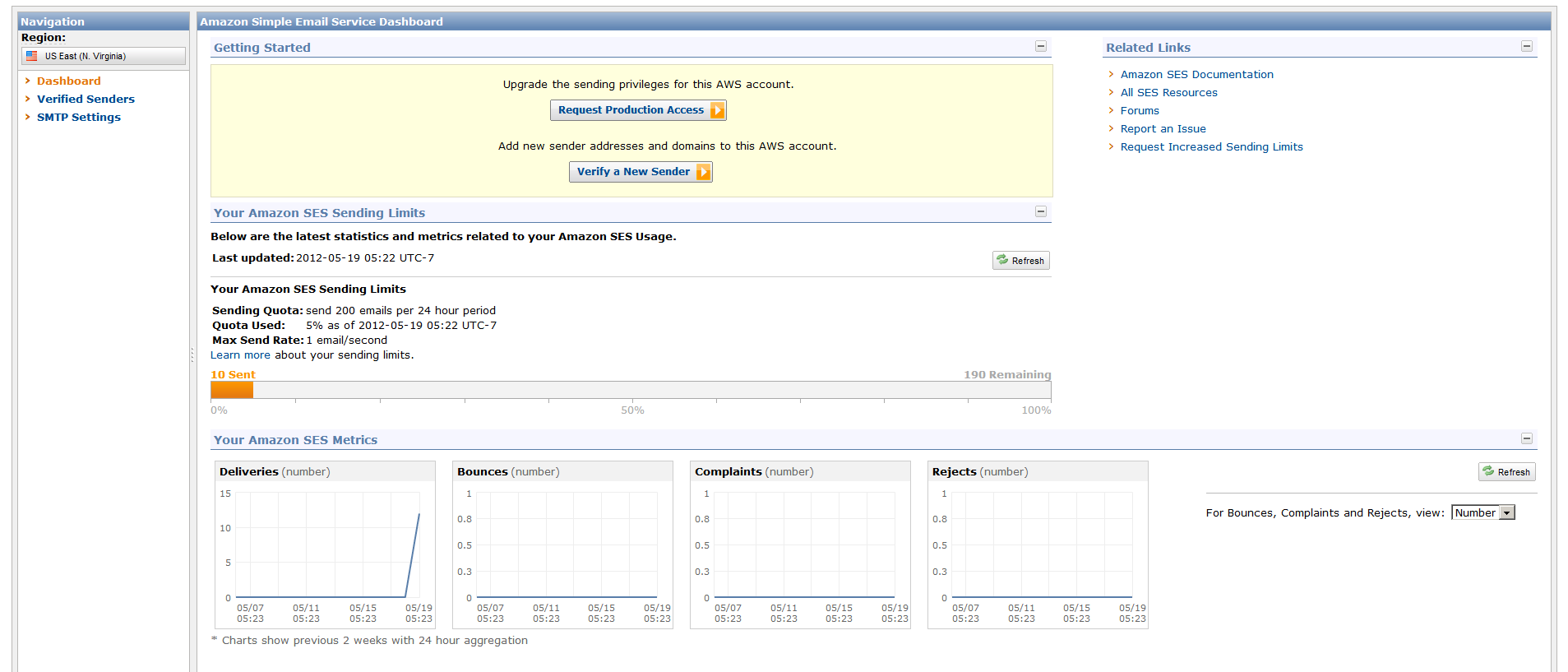
- When you first sign up for SES, you will be assigned a “Sandbox” account. Which means that you will only be able to send emails TO and FROM verified email addresses (a verified email address is something you add yourself to your SES account and then click on a confirmation link that Amazon sends you, to prove that you are the owner of that email id). Also, Sandbox access allows you to send out a maximum of just 25 emails per day, both FROM and TO verified email id’s only.
- So the first step is to add a Verified Sender. So click on the “Verified Senders” link in the menu on the left.
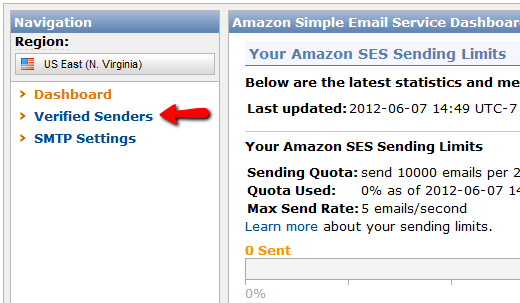
- That will bring you to this page. Click on the Verify a New Email Address link with the green check-mark next to it.
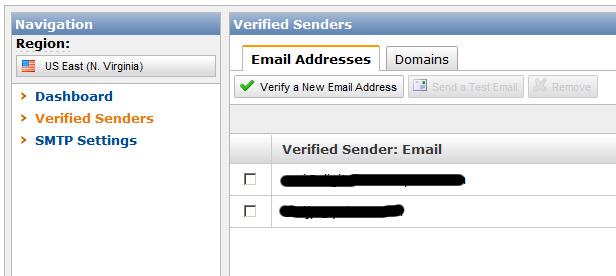
- In the popup, enter the email id that you wish to use as your FROM email id to send out emails. Please note that you can ONLY use verified email id’s to send out emails from your Amazon SES account. So whatever email id you wish to use in DAP Admin as the sender for outgoing emails (see DAP Admin > Setup > Config > From-Email Id : For all outgoing DAP emails), that’s the email id you should verify.IMPORTANT: The email address is case sensitive. So if you white-listed You@YourSite.com at Amazon SES, then you must enter the email address with the exact same cAsE within DAP Config too (You@YourSite.com is NOT the same as you@yoursite.com for the purposes of Amazon SES. Crazy, we know! But that’s how it is.)
- You will then receive an email from Amazon at that email id which has a confirmation link. Once you click on that link, your email id in your Amazon SES account is now “Verified” (also known as whitelisted). Please note that at this time, you still have Sandbox access. Which means you can send email both FROM and TO the same verified email id. Not very useful, but that’s ok. Now time to go back to the SES Dashboard and Request Production Access.
- Click on Request Production Access and you will be taken to a form that you need to fill out and submit. Amazon then reviews it, and it can take up to 48 hours for your account to be granted Production Access – which basically means, you can now use SES and start sending out real emails, and your per-day limit is now 10,000 emails per day.
- Now, you need to get a SMTP Username and SMTP password for sending out emails. This username & password is NOT the same as your Amazon account email and password. Neither does it have anything to do with your Amazon Public or Secret keys. This is a completely different (and new) username and password used JUST for sending emails, and it needs to be generated newly.
- To generate a new set of SMTP Username and Password, click on the SMTP Settings link in the menu. And then on the next page, click on Create My SMTP Credentials.
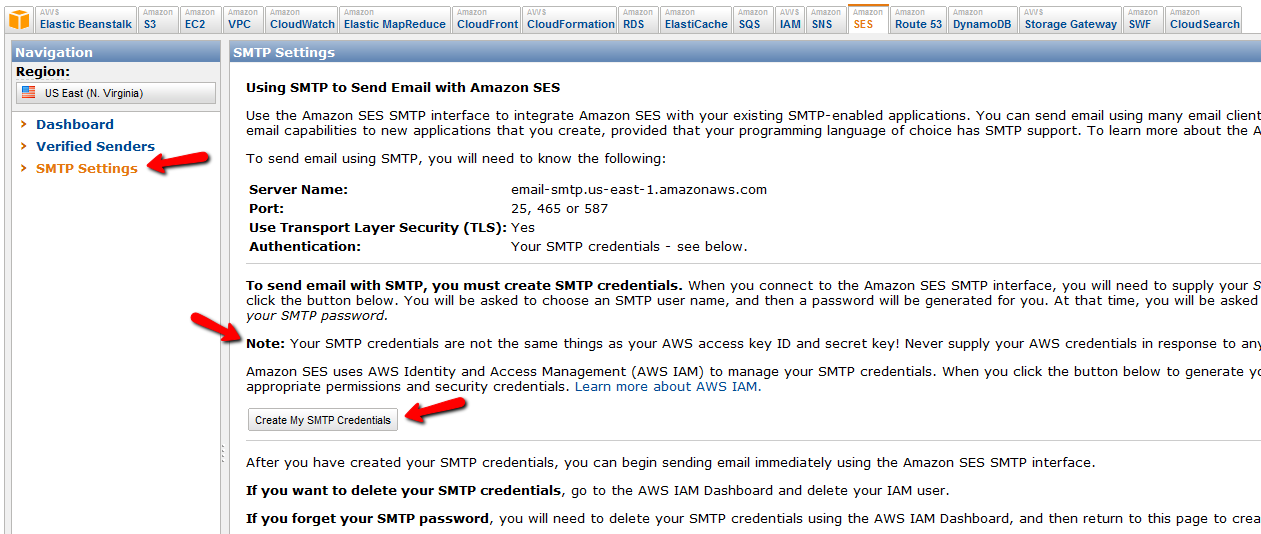
- In the resulting popup, click on Create.
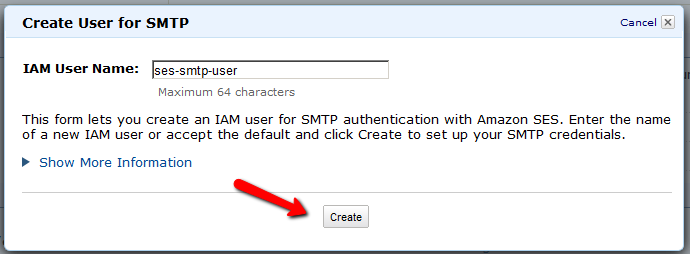
- That will create your SMTP credentials. But to see it, you have to click on Show User SMTP Security Credentials
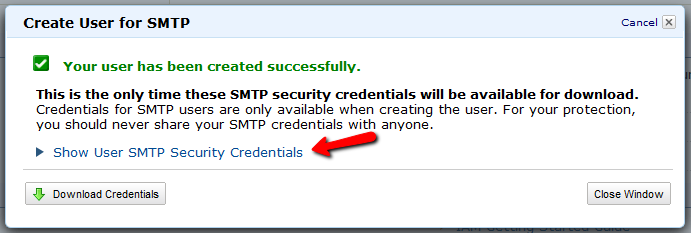
- Once you click on Show User SMTP Security Credentials, you will be shown your SMTP Username and Password.

- Be sure to note down the username and password in a safe place where you can get to it again, because Amazon will not show this same set of username and password ever again. If you lose them, of course, you can always generate a new set of username/password again for free, but you’ll never get the same pair again – it will be a fresh pair.
- Go to the SMTP Settings link in the menu and note down the Server Name.
It will be one of the following:
email-smtp.us-east-1.amazonaws.com (as in the image below)
email-smtp.us-west-1.amazonaws.com
email-smtp.eu-west-1.amazonaws.com (European Union users)
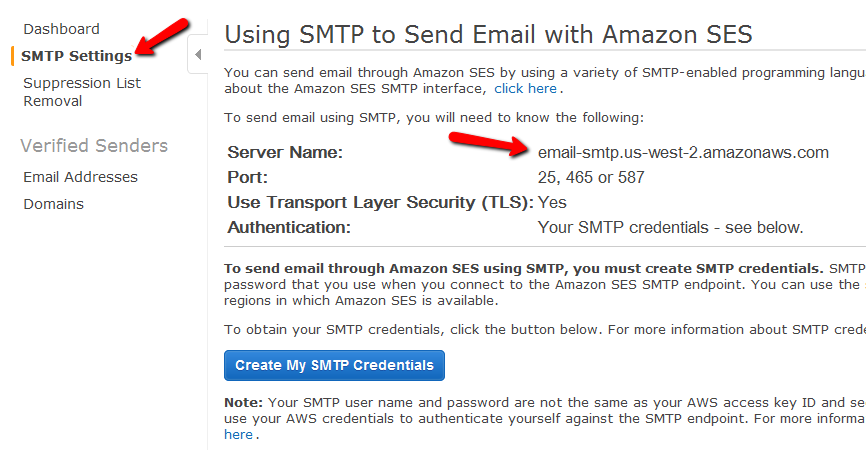 You need to determine what your host name is, and then add the text “ssl://” to it at the front.
You need to determine what your host name is, and then add the text “ssl://” to it at the front.
So if the server name displayed in your Amazon SES account is this…
email-smtp.us-east-1.amazonaws.com…then the text you would enter into the DAP Email > SMTP page is this…
ssl://email-smtp.us-east-1.amazonaws.com - Now log in to your DAP Admin Panel, and go to DAP Admin > Email > SMTP.
- On this screen, use the section Add a New SMTP Server to create a new SMTP row as follows:

(Click on image above to see full-size screenshot)
Description: Amazon SES
Server: <what you noted down above>
Port: 465 (must be exactly that – ignore port numbers recommended by Amazon SES)
SSL: N (must be exactly that)
User Id: Amazon SMTP Username (that you generated and noted down in Step 15 above)
Password: Amazon SMTP Password (that you generated and noted down in Step 15 above)
Email Sending Limit Per Hour: 500 (ideal number – don’t go more – less is ok)Click on the “Add” button to create and save the new Amazon SES SMTP server setting in DAP. - Once it is saved, now you will see 2 rows on the “Email > SMTP” screen. One is for the server “Localhost”, and the other is the new “Amazon SES”.
- Towards the end of each row, you’ll see a setting called “Activated?”. Set it to “N” for Localhost and “Y” for Amazon SES.
- That will now make all of your outgoing emails (listed below) go out only through Amazon SES, totally bypassing your web host’s email server. Which means, your email deliverability will go up substantially.
- List of outgoing emails include:
– Real-time Welcome Emails
– All transactional emails to DAP Admin – like payment receipt, new user signup, error notifications, user unsubscription notifications, etc
– All autoresponder and broadcast emails
– etc…
Watch this video for details:
DAP integration with 2Checkout
DAP now integrates with 2CO!
To integrate DAP with your 2CO account, pls update the IPN in your 2CO account to point to http://yoursite.com/dap/dap-2co.php (replace yoursite.com with the name of your site) for the following events:
– Order Created
– Fraud Status Changed
– Recurring Installment Success
– Recurring Installment Failed
– Recurring Restarted
NOTE: When you create products in 2CO to sell, make sure you create products by the EXACT same name in DAP otherwise the transaction will not be processed by DAP.
Here’s how the script will work:
1) Order Created
DAP will create and activate the membership account at the time of purchase.
DAP will look for the message type of ORDER_CREATED and invoice_status of “approved” to automatically create the membership account. The user will receive the welcome email with full access to the purchased items (based on content drip settings in dap products page) upon purchase completion.
2) Fraud Status Changed
2CO approves or disapproves a purchase inmediately. If the purchase is approved, DAP will receive an “Order created” message via IPN from 2CO; if not, 2CO will not send any message. After that, 2CO has a “second tier” fraud check. Upon the completion of Fraud Check, 2CO will send out FRAUD_STATUS_CHANGED message. DAP will not take any action if fraud_status = “pass”. But if fraud_status in NOT “pass”, then dap will set the user’s product status in DAP to INACTIVE. So the user will not be able to access the DAP product any more.
3) Recurring Installment Success
Upon successful recurring payment notification from 2CO, DAP will simply extend the user’s access end date based on the ‘recurring cycle’ setting in dap products page -> Price/Recurring tab for the product.
4) Recurring Installment Failed
DAP will reset the access end date to current date if recurring payment fails so user will not be able to access content past the failed date.
5) Recurring Restarted
DAP will start back from where the user last left off. The user’s access end date will be extended from whatever it was set to previously. The access end date is extended based on the recurring period settings in the dap products page -> Price/Recurring tab for the product.
MSIAB STARTER: How It Works And Other FAQ
(For information about the MSIAB Pro package, click here.)
Here’s how the MSIAB “Starter” Concierge sessions work:
* Please note that with the “Starter” Concierge service, you get a total of *3 hours* of 1-on-1 setup and configuration and DAP walk-thru. So you’re free to manage those 3 hours of time you’re getting, by guiding us to focus on the things most important to you (like MailChimp Integration, Content Protection, Affiliate Setup, etc).
* Any time left over from either the 1-on-1 call or the offline time, may not be re-used for any other purposes (like, asking us to additional software installation, etc). Any time left unused will be forfeited if not used within 6 months (180 days).
* The bonuses or time provided may not be transferred to others.
* So after you purchase the MSIAB license, pls open a ticket at http://DigitalAccessPass.com/support/ with all of the following site credentials that we will need for installaing DAP on your site.
* Then we set up a 2-hour call with you, give you a crash-course in using DAP, set up end-to-end of a product, set up your various member-facing pages, go over all of your questions, etc.
* And then, we recommend that you take a few days to use DAP by yourself, play with the different settings and options, set up the rest of of your actual content, create your actual products, decide on the pricing, create your sales pages, squeeze pages, etc.
* By this time, you will have more questions, and more ideas. So, at that point, contact us via the same ticket as before, and request your final 1-hour Concierge session. During this final call, we can go over any other questions you may have, or anything else you may need help with in completing the set up of your membership site.
While we actually don’t require anything to be setup ahead of the calls, the more components you have already set up (or have made some progress on, or have at least given a thought to) going into the call – like your theme look & feel, your nav menu, your pages, sub-pages, Aweber email sequence, etc), the quicker you will be able to launch after the calls.
The only thing we really need is for you to have absolutely every third-party component’s login and password information handy and available – like Aweber login, WP admin, FTP, Authorize.net/Paypal/ClickBank/other, Web hosting cPanel, etc).
We may need most of it during setup (you don’t *have* to give it to us – you must at least be able to log in yourself and follow our instructions on the call – we can help you by allowing you to share your screen and walking you through the steps).
And you’ll really benefit from watching some of our videos ahead of time – like the tutorial videos we have added, at http://DigitalAccessPass.com/documentation/ (at the top on the menu on the left, look under the “DAP Tutorials: End-to-End” section).
So, to summarize, here’s a list of things that we can and cannot do.
What we CAN do:
* Set up your member pages: Login page, “My Content” page, “My Affiliate” page and “Profile” page
* Setup up to 6 different products or “levels”
* Set up any free products, and show you how to sign up free members
* Set up the DAP shopping cart if required and connect it to a supported payment gateway
* Create buy buttons for your various products, and set it all up so that people can go from your site to buying your product to being logged in to the member’s area
* Walk you through end-to-end testing of your sales funnel
* Integrate DAP with your payment processor or 1SiteAutomation.com cart
* Setup 1-Click Upsells if you’re going to offer them
* Set up “Self-Service Store” – which is our “Credits” plugin and integrate it with your products and your content, so that you can award your members with “Credits”
* Setup and install vBulletin and integrate it with your membership levels or products so that certain members can access certain forums only
* Set up full content protection, content dripping, product chaining
* Set up email autoresponders and show you how to do broadcasts
* Set up your affiliate program, commissions for your various products, set up the affiliate info page for your members, and show you how to run reports and also pay your affiliates, etc
What we WILL NOT be doing:
* Designing your web site headers, graphics, skins, css, etc
* Create any kind of web site content, videos, write articles, blog posts or pages, etc
* Create your navigation, menu, organizing or arranging your content, etc
* Setup your squeeze pages, launch funnel, etc

